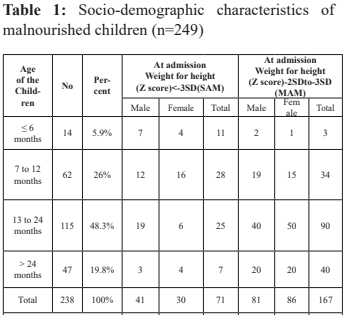Abstract
Introduction: The burden of malnutrition is of
significant concern in Nepal. The objectives of this study
are to classify the nutritional status in children admitted
in nutritional rehabilitation home of Pokhara Academy
of Health Sciences and to relate the demographic
characteristicsand the effectiveness of the nutritional
intervention measures on status of malnutrition which
can help in the policy formulation to tackle the burden
of malnutrition.
Materials and Methods: This is a hospital based
retrospective study in which total of 238 children with
malnutrition admitted in nutritional rehabilitation home
of Pokhara Academy of Health Sciences during July 2014
to July 2018 were followed. The socio-demographic
factors and nutritional status were analyzed at admission
and at discharge using the available record. Data was
analyzed using SPSS 16.
Results: Out of 238 malnourished children, 167(70.2%)
were cases of moderate acute malnutrition and 76(29.8%)
were cases of severe acute malnutrition. The mean
weight at admission was 7.18±1.73 kg, mean weight at
discharge was 7.82±1.82 kg and mean weight increased
after nutritional intervention was 0.62 kg±0.40. The
average weight gain in severe acute malnutrition was
4.7gm/kg/day. A statistically significant difference was
obtained between meanweight (p=0.00, t= - 24.62) of
children at admission and discharge.There was significant
statistical difference between mean weight gain (p<0.05,
t= -3.1) in severe acute malnutrition (0.76±0.49 kg) and
in moderate acute malnutrition (0.59±0.34 kg).
Conclusion: Nutritional rehabilitation homes are
effective in improving the nutritional status of
undernourished children, more effective in severe acute
malnutrition. However it is important to reassess the
management protocol to meet the intake targets so that
the rate of weight gain is improved.
References
ERA and ICF International Inc. Nepal Demographic
and Health Survey 2016. Maryland, Kathmandu:
Ministry of Health and Population, New Era and
ICF International; 2017.
2. Black RE, Allen LH, BhuttaZA,Caulfield LE,
Onis MD, Ezzati M et al. Maternal and Child Under
nutrition .Global and regional exposures and health
consequences. Lancet.2008;371(9608):243-260.
3. Richard SA, Black RE, Gilman RH, Guerrant
RL, Kang G, Lanata CF et al. Wasting is associated
with stunting in early childhood. Journal of
Nutrition.2012;142(7):1291-1296.
4. Ministry of Health and Population (MOH).
Sustainable Development Goal (SDG) Targets.
Kathmandu, Nepal: MOH;2017.
5. World Health Organization. Pocket book of
hospital care for children: guidelines for the
management of common childhood illnesses – 2nd
edition. Geneva World Health Organization 2013.
p 215
6. Ningadalli SG, Angolkar M, Herekar VR,
Hirachand AG, Sah JK, Madikar S. Impact of
facility based dietary management on severe acute
malnutrition in children aged 6 to 60 months
Admitted in Nutritional Rehabilitation Centre of
KLES Dr. PrabhakarKoreHospital of Belagavi
City -A Longitudinal Study.International Journal
of Science and Research (IJSR) 2015: 4(5):2133 –
2137
7. Irena AH, Mwambazi M, Mulenga V. Diarrhea
is a major killer of children with severe acute
malnutrition admitted to inpatient set-up in Lusaka,
Zambia. Nutr J 2011; 10:110.
8. Chiabi A, Malangue B, Nguefack S, Dongmo
FN, Fru F, Takou V, et al. The clinical spectrum of
severe acute malnutrition in children in Cameroon:
a hospital-based study in Yaounde, Cameroon.
TranslPediatr. 2017;6(1):32-39.
9. Ubesie AC, Ibeziako NS, Ndiokwelu CI, Uzoka
CM, Nwafor CA. Under-five protein energy
malnutrition admitted at the University of Nigeria
Teaching Hospital, Enugu: A 10-year retrospective
review. Nutr J 2012;11:43.
10. Hossain MI, Dodd NS, Ahmed T, Miah GM,
Jamil KM, Nahar B, et al. Experience in managing
malnutrition in a government tertiary treatment
facility in Bangladesh. Journal of Health Population
and Nutrition 2009; 27(1):72- 80.
11. Taneja G, Dixit S, Khatri AK, Yeslikar AK,
Raghunath D, Chourasiya S.. A study to evaluate
the effect of nutritional intervention measures on
admitted children in selected nutrition rehabilitation
centers of Indore and Ujjain divisions of the state
of Madhya Pradesh, India. Indian Journal of
Community Medicine 2012;37(2):107-115.
12. Schneideman I, Bennett FJ, Rutishauser IHE.
The nutrition rehabilitation unit at Mulago hospital-
Kampala: Development and evaluation, 1965–67. J
Trop Pediatr Environ Child Health. 1971;17(1):25-
34
13. Colecraft EK, Marquis GS, Bartolucci AA,
Pulley LV, Owusu WB, Maetz HM. A longitudinal
assessment of the diet and growth of malnourished
children participating in nutrition rehabilitation
centres in Accra, Ghana. Public Health Nutrition
2004;7(4):487-494
14. Savadogo, L., Zoetaba, I., Donnen, P., Hennart,
P., Sondo, B. K., &Dramaix, M. (2007).Prise en
charge de la malnutrition aiguësévèredansuncentre
de réhabilitation et d’éducationnutritionnelleurbain
au Burkina Faso [Management of severe acute
malnutrition in an urban nutritional rehabilitation
center in Burkina Faso]. Revue d’epidemiologieet
de santepublique 2007; 55(4):265–274.
15. Patel D, Upadhyay N.Evaluation of
anthropometric indicators in malnourished children
at nutritional rehabilitation center, Gujarat, India.Int
J ContempPediatr2019 ;6(4):1410-1413

